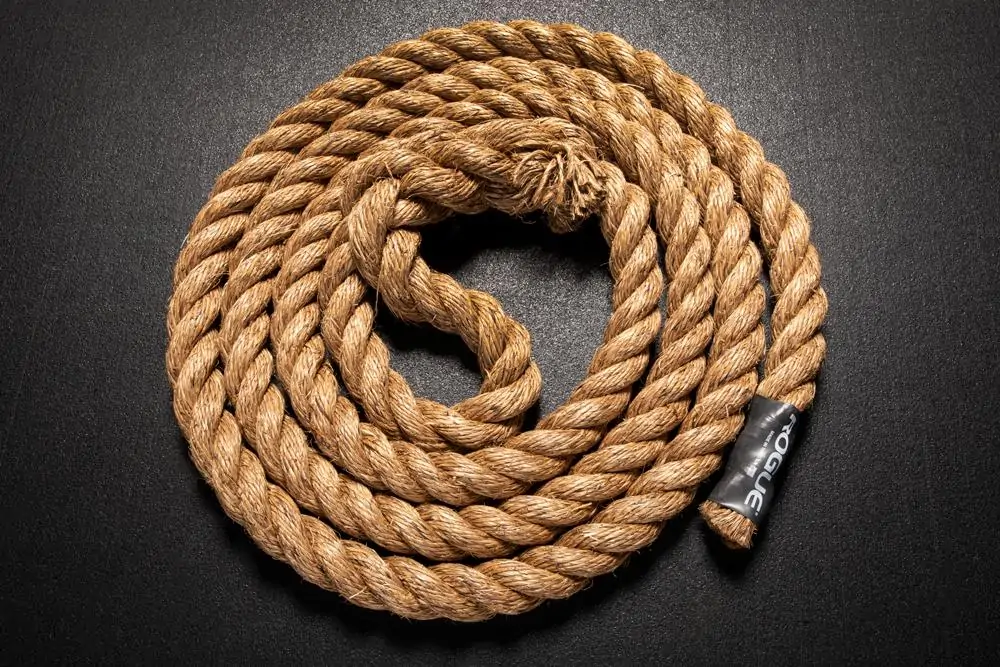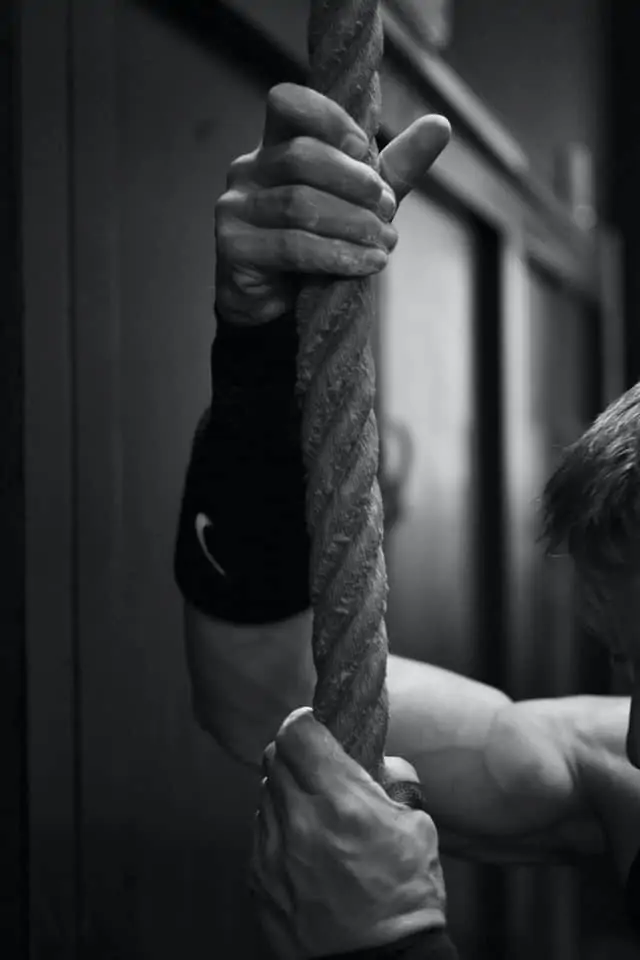Top athletes have incorporated climbing into their fitness routine for years. The true grit, strength, and tenacity required to complete a climb are what keeps fitness junkies coming back for more. As an avid climber myself, I tested three products. I found Rogue Manila CrossFit climbing ropes to be an overall best choice for athletes and beginners alike – providing a sturdy build with a wide variety of uses.
While you usually find climbing ropes in commercial gyms, they are one of the best tools to make immense progress at home. I found a garage with high ceilings or a backyard provides the perfect setup. I made it my task to source the best equipment on the market to climb safely and enjoyably at home.
You see, climbing is complex, and unlike other gym equipment, you are suspended feet above the ground, with nothing but the strength of your body and the structure of a rope to hold you. You want a quality rope that is built to last and offers different exercises all in one. Whether you are a beginner or an experienced climber, each rope has advantages and disadvantages. Keep reading as I discuss this sport’s intricacies so you can make an informed decision before purchasing the best climbing rope.
| Product | features | Max Weight | Score | |
|---|---|---|---|---|
TOP PICK |
Rogue Manila Climbing Rope
|
N/A | ||
 |
Perantlb Climbing Rope
|
500 lbs | ||
 |
Polydac Gym Climbing Rope
|
N/A |
Best Crossfit Climbing Ropes Review
Climbing ropes come in many varieties nowadays, and if you’ve never had the chance to feel how humbling a training tool they are you might be up for a discussion. In my opinion, the best climbing ropes are the ones that are made of natural materials, such as Manila, jute, hemp, or cotton.
The reason why I use the term Crossfit in this climbing rope review is that a little more than recently this sport gave rebirth to the by the way age old rope climbing as its fundamental competition exercise. So nowadays, in the gym exercise and bodyweight training world, rope climbing is rather associated with Crossfit. It follows from this that Crossfit set new standards for the best climbing ropes in terms of tensile strength and easy of use and material quality.
I put my time in to find and review 2 of the best climbing ropes that would allow you to exercise on Crossfit level intensities and 1 made of polyester that could not have been left out of a climbing rope review. This synthetic material has its own unique benefits hence widely used across gyms, marine, and military worldwide.
#1 Best Overall: Rogue Manila Climbing Rope
When you think of CrossFit climbing ropes, this is what comes to mind. The Rogue Manila Climbing Rope has a heavy-duty weave with various length options – making it adaptable to indoor and outdoor training spaces. As the best climbing rope, it has the highest quality material; American-made manila.
This offers durability and a dependable grip, essential in army camps across the country. If you want a military fitness routine, this is the rope for you.
This product cleverly requires no metal attachment clasps – meaning it will need to be tied to secure the rope. This is a much safer way to climb. No clasp means no break and no injury.
Also, a Manila rope is easy to handle, bending and tying knots should not be an issue. One thing though, when wet, manila is prone to shrinking to about 10% of its original length.
The Rogue Manila Rope featured in the Crossfit Games is designed for climbing fundamentals and heavy use, hence a superb choice for new and experienced climbers who plan to use the rope often.
Pros:
- Sturdy build with durable manila hemp material
- 5 different length options
- Braided eyelet with no mounting bracket required.
Cons:
- Possible splintering over time (this is common in many ropes)
>>CHECK PRICE ON ROGUEFITNESS<<
#2 Best for Outdoors: Perantlb Outdoor Climbing Rope
This rope has made outdoor climbing its home and comes in six different length ranges, with the longest being 50 feet. The length adjustment makes it easy for both professional and beginner athletes to try many other exercises.
The Perantlb Outdoor Climbing Rope is heat shrunk, preventing fraying when exposed to the outdoor elements. It is made of jute and can support up to 500lbs and does not require a mounting bracket.
Jute ropes are also more heat resistant than other natural fiber ropes and don’t stretch that much.
This rope design makes it perfect for those who love the outdoors and want a sturdy support system while braving the weather. However, the jute rope material can sometimes be uncomfortable to climb with.
Pros:
- Best climbing rope for outdoor climbing
- 500lbs weight capacity
- Heat shrunk to prevent fraying
- No metal clasps and can be installed easily.
Cons:
- It doesn’t include an anchor kit
- About 20% weaker compared to manila
#3 Best for lighter people: Polydac Gym Climbing Rope
I know the title suggests otherwise, but the Polydac is an exception. This rope is not a CrossFit climbing rope. This is the type of rope you will see in school gyms or used as a tug of war battle rope.
Because of its soft and slippy polyester material, it doesn’t have the same sure grip and feel as other ropes of natural material. The upside is, that basically polyester is completely water-resistant. The fibers can’t absorb moisture, so rotting or mildew buildup is very unlikely.
While still good to use as a climbing rope, it is mainly used by armatures or those new to the sport. It is more slippery by default than other natural rope materials, which coupled with rain or humid weather becomes even more of a concern.
Pros:
- The polyester material is soft to touch and has a high resistance to outside conditions
- Cheaper than other ropes
- Best used outdoors for climbing if the weather is rather dry
Cons:
- Metal eyehook means a small weight capacity
- Becomes very slippery when wet
Things to Know About Rope Climbing
Different rope climb exercises
Like all fitness routines, the way you execute an exercise can drastically change its effect on your body. Whether it’s the row to pull up or the butterfly assists climb, the video below outlines some of the best techniques to get you started.
How to use a climbing rope for your workout?
For CrossFit climbing ropes, you will find two distinct styles: the basic and legless rope climb.
Basic
The basic rope climb uses footwork, and upper body works to propel you up the rope. The J wrap technique involves scissoring the rope into a J shape and locking it securely on the inside of your foot. It should feel tight, and you shouldn’t feel a slip. This technique takes practice, and even if you have the best climbing rope, it can be difficult.
Legless
As the name suggests, this technique is a hands-only method and requires a forward hip thrust that creates momentum up the rope. When doing this, it’s crucial to get a rhythm with your movement, similar to that of a muscle-up.
Benefits of CrossFit climbing ropes on your muscles
The rope climb trains your biceps, lats, and shoulders, all in one go. A climb also helps establish core strength, stabilization, and coordination. Climbing rope forces you to build up whole body tension, otherwise, you fall. It’s hard to imagine a bodyweight workout that builds such an amount of strength in a more functional way. Rope climbing is one of the most humbling bodyweight exercises there is.
Benefits of CrossFit climbing ropes on your health
An exercise such as a vertical climb has impressive health benefits. Studies involving pull-ups have found that regularly performing strength training may reduce visceral fat, lower blood pressure, and lower back pain associated with arthritis.
Crossfit Climbing Rope Buying Guide
What to think about before buying
Every rope is different, and it’s important to know what to look out for when shopping for CrossFit climbing ropes. How often you are going to use it is one primary factor as well as other circumstances like outdoor use, safety, anchoring.
Just so you know, the chances of a rope designed for climbing tearing apart is quite low, however not impossible, and depends on humidity, UV exposure, whether you use chalk, and a host of other factors.
Also, if you don’t want to take chances you may want to check out the following instructable on how you can make one hell of a tough climbing rope yourself.
Climbing rope v battle rope
People use ropes to build upper strength through climbing. On the other hand, battle ropes condition various muscle groups, enhance cardiovascular endurance and have a more versatile set of exercise possibilities.
What material to choose
Most climbing ropes feature manila hemp or thick nylon. Manila hemp is more durable and is common in military bases while nylon is mostly used in shipyards due to its water and UV resistance. However, these are not set in stone:


Durability is key
When it comes to ropes, there is no question that every rope needs to be durable. However, some new ropes are too slippery at first and need to be broken in with chalk until they are easier to climb.
Thickness is important
The average diameter of an adult’s hand is 1.5″, and the thickness of the rope determines how good your grip is when attempting a climb.
Know the length
This depends on where you intend to hang your rope. It could be a low ceiling garage or a higher point outside. It’s important to note that hemp ropes often stretch over time. Giving some slack and starting them off at least three feet off the ground is advised.
Check the weight capacity
A decent climbing rope will have a weight capacity of 300lbs. This will change depending on the anchor point of the rope and its style.
The most common ones are twisted climbing ropes, which offer a unique grip that I think is best for secure climbing. Braided climbing ropes are quite rare and rather used as battle ropes for conditioning despite the fact that braided ropes have higher tensile strength.


Still, the fact that climbing ropes are predominantly twisted is due to cheaper manufacturing costs and that they offer more than enough strength for bodyweight climbing anyway.
Consider how easy it is to install
When it comes to safety, installation is the most crucial aspect of even the best climbing rope. If you don’t have something to tie your rope around, look for ropes with an eye hook feature built-in, making it easy to clip.
Conclusion
There are many options for climbing ropes, with each providing its own set of specific features and uses. When you are looking for the best Crossfit climbing rope, the Rogue Manila Climbing Rope is the go-to. Made with manila hemp, five different length versatilities, and braided eyelets, this rope makes climbing safe and enjoyable. The material is sought after worldwide, so it’s no wonder this is the first choice for the US army. Make this rope a regular part of your home workout, and watch your body and health transform.



